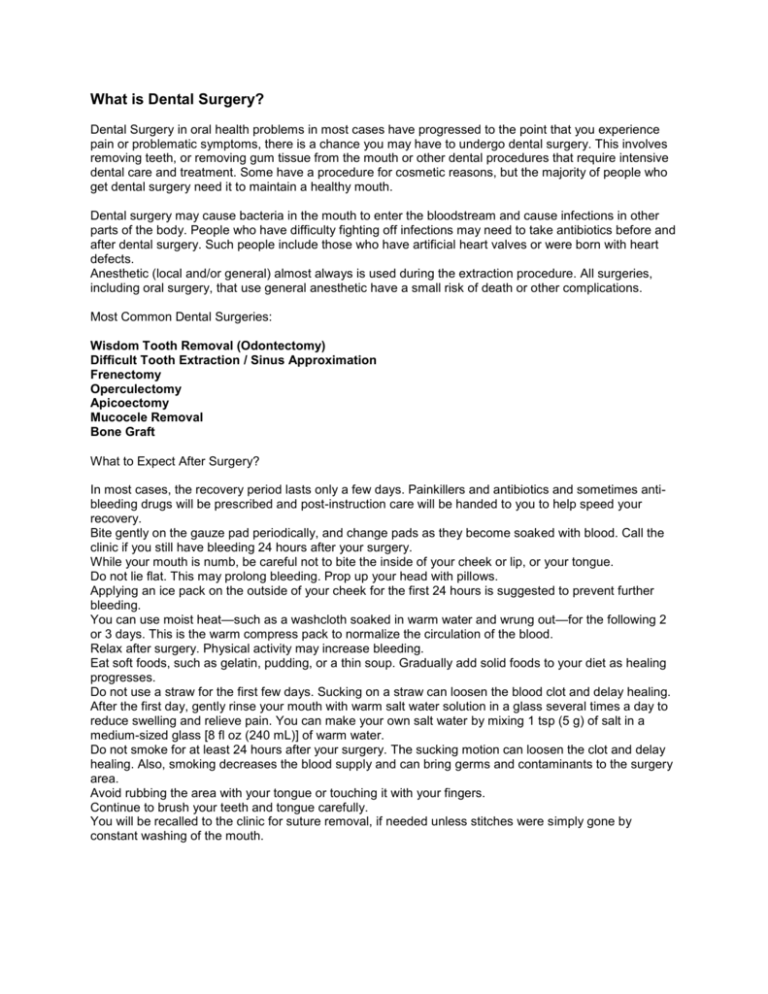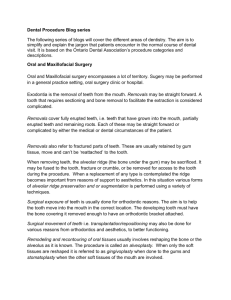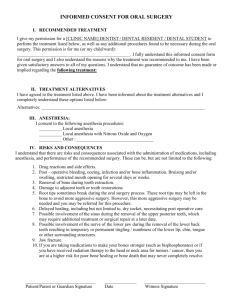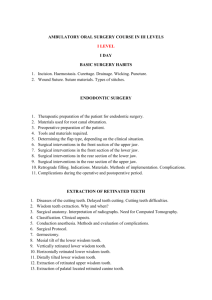What is Dental Surgery
advertisement

What is Dental Surgery? Dental Surgery in oral health problems in most cases have progressed to the point that you experience pain or problematic symptoms, there is a chance you may have to undergo dental surgery. This involves removing teeth, or removing gum tissue from the mouth or other dental procedures that require intensive dental care and treatment. Some have a procedure for cosmetic reasons, but the majority of people who get dental surgery need it to maintain a healthy mouth. Dental surgery may cause bacteria in the mouth to enter the bloodstream and cause infections in other parts of the body. People who have difficulty fighting off infections may need to take antibiotics before and after dental surgery. Such people include those who have artificial heart valves or were born with heart defects. Anesthetic (local and/or general) almost always is used during the extraction procedure. All surgeries, including oral surgery, that use general anesthetic have a small risk of death or other complications. Most Common Dental Surgeries: Wisdom Tooth Removal (Odontectomy) Difficult Tooth Extraction / Sinus Approximation Frenectomy Operculectomy Apicoectomy Mucocele Removal Bone Graft What to Expect After Surgery? In most cases, the recovery period lasts only a few days. Painkillers and antibiotics and sometimes antibleeding drugs will be prescribed and post-instruction care will be handed to you to help speed your recovery. Bite gently on the gauze pad periodically, and change pads as they become soaked with blood. Call the clinic if you still have bleeding 24 hours after your surgery. While your mouth is numb, be careful not to bite the inside of your cheek or lip, or your tongue. Do not lie flat. This may prolong bleeding. Prop up your head with pillows. Applying an ice pack on the outside of your cheek for the first 24 hours is suggested to prevent further bleeding. You can use moist heat—such as a washcloth soaked in warm water and wrung out—for the following 2 or 3 days. This is the warm compress pack to normalize the circulation of the blood. Relax after surgery. Physical activity may increase bleeding. Eat soft foods, such as gelatin, pudding, or a thin soup. Gradually add solid foods to your diet as healing progresses. Do not use a straw for the first few days. Sucking on a straw can loosen the blood clot and delay healing. After the first day, gently rinse your mouth with warm salt water solution in a glass several times a day to reduce swelling and relieve pain. You can make your own salt water by mixing 1 tsp (5 g) of salt in a medium-sized glass [8 fl oz (240 mL)] of warm water. Do not smoke for at least 24 hours after your surgery. The sucking motion can loosen the clot and delay healing. Also, smoking decreases the blood supply and can bring germs and contaminants to the surgery area. Avoid rubbing the area with your tongue or touching it with your fingers. Continue to brush your teeth and tongue carefully. You will be recalled to the clinic for suture removal, if needed unless stitches were simply gone by constant washing of the mouth. What is Wisdom Tooth Removal? A wisdom tooth removal is also known as odontectomy. A dental surgeon or dentist can remove (extract) wisdom tooth. The procedure often can be done in our clinic. You may have the surgery in the hospital, especially if you are having all your wisdom teeth pulled at one time or if you are at high risk for complications. If you have any infections, surgery will usually be delayed until the infection has cleared up. You will be prescribed to take antibiotics to help heal the infection. Before removing a wisdom tooth, you will be given local anesthetic to numb the area where the tooth will be removed. A general anesthetic may be used, especially if several or all of your wisdom teeth will be removed at the same time. A general anesthetic prevents pain in the whole body and will cause you to sleep through the procedure. You will be recommended not to eat or drink after midnight on the night before surgery so that you are prepared for the dental surgery. To remove the wisdom tooth, the gum tissue over the tooth will be incised and removal of bone will be drilled out that is covering the tooth. The tissue connecting will be separated from the tooth to the bone and then remove the tooth. Most cases, the tooth will be cut into smaller pieces to make it easier to remove. After the tooth is removed, you may need stitches. Some stitches dissolve over time and some have to be removed after a few days. You will be told when your stitches need to be removed. A folded cotton gauze pad placed over the wound will help stop the bleeding. Why Wisdom tooth Should Be Removed? A wisdom tooth is extracted to correct an actual problem or to prevent problems that may come up in the future. When wisdom teeth come in, a number of problems can occur: Your jaw may not be large enough for them, and they may become impacted and unable to break through your gums. Your wisdom teeth may break partway through your gums, causing a flap of gum tissue to grow over them. Food and germs can get trapped under the flap and cause your gums to become red, swollen, and painful. These are signs of infection. More serious problems can develop from impacted teeth, such as infection, damage to other teeth and bone, or a cyst. One or more of your wisdom teeth may come in at an awkward angle, with the top of the tooth facing forward, backward, or to either side. How Well It Works? Wisdom tooth removal usually is effective in preventing: Crowding of the back teeth. A wisdom tooth becoming stuck in the jaw (impacted) and never breaking through the gums. Red, swollen, and painful gums caused by a flap of skin around a wisdom tooth that has only partially come in. Gum disease and tooth decay in the wisdom tooth, which may be harder to clean than other teeth, or in the teeth and jaw in the area of the wisdom tooth. What are the Risks? After a wisdom tooth is removed, you may experience: Pain and swelling in your gums and tooth socket where the tooth was removed. Bleeding that won't stop for about 24 hours. Difficulty with or pain from opening your jaw (trismus). Slow-healing gums. Damage to existing dental work, such as crowns or bridges, or to roots of a nearby tooth. A painful inflammation called dry socket, which happens if the protective blood clot is lost too soon. Numbness in your mouth and lips after the local anesthetic wears off, due to injury or inflammation of nerves in the jaw. Rare side effects, including: Numbness in the mouth or lips that does not go away. A fractured jaw if the tooth was firmly attached to the jaw bone. An opening into the sinus cavity when a wisdom tooth is removed from the upper jaw. What to Think About? If your wisdom teeth are not causing problems, it may be difficult to decide whether to have these teeth removed to prevent possible dental problems later in life. Think about the following: You may never have any problems with your wisdom teeth. It is rarely harmful to your health to have your wisdom teeth removed, but there are slight risks involved with any surgery. In younger people (late teens and early 20s), the wisdom tooth's roots are not fully developed and the jaw bone is not as dense, so it is easier to remove the tooth. The easier it is to remove the tooth, the easier your recovery is more likely to be. Most problems with wisdom teeth develop between the ages of 15 and 25. If you are older than age 30, you have only a small risk of having problems with your wisdom teeth. Few people older than 30 develop problems that require removal of their wisdom teeth. Possible complications include dry socket (alveolar osteitis), infection, bleeding, and numbness. Women on birth control pills who decide to have their wisdom teeth removed should try to schedule the surgery for the end of their menstrual cycle (usually days 23 through 28). There seems to be less risk of dry socket during this time. What is Frenectomy? Labial Frenectomy is a form of surgical incision of frenum or frenulum performed on the upper lip. The labial frenulum often attaches to the center of the upper lip and between the upper two front teeth. This can cause a large gap and gum recession by pulling the gums off the bone. A labial frenectomy removes the labial frenulum. Orthodontic patients often have this procedure done to assist with closing a front tooth gap. When a denture patient's lips move, the frenulum pulls and loosens the denture which can be uncomfortable. This surgery is often done to help dentures fit better. The removal of the frenulum does not cause any adverse effects to the lip and mouth. What is an Apicoectomy? An Apicoectomy, or Root-End Resection, is the removal of the root tip and the surrounding infected tissue of an abscessed tooth. This procedure may be necessary when inflammation and infection persists in the area around the root tip after root canal therapy or root canal retreatment. Step one: After the tooth is "numbed", the gum is reflected (lifted) to uncover the underlying bone and the root end of the tooth. The root-end is resected (removed) with all the surrounding infected tissue. Step two: A root-end filling is placed to seal the end of the root canal, the gum is repositioned, and a few dissolvable sutures (stitches) are placed to hold the gum tissue back in its place until healing occurs. Step three: After a few months, the bone around the root-end has healed, and all symptoms are gone. What is Operculectomy? Operculectomy is a kind gingivectomy (removal of the gums) that is related to wisdom tooth that has not emerged. During the intervention operculum, the part of the gum around and above the wisdom teeth, is removing. Is it painful? It is under local anesthesia and it is not painful. How long does it take? It takes very short. What is a Mucocele? Mucocele are tiny bluish colored sacs located on the floor of the mouth under the tongue that are filled with fluid. They are not generally harmful but can cause discomfort and stress on the person inflicted with it. It does not require serious medical attention as it usually resolves spontaneously within 3 to 6 weeks. Mucocele Symptoms Mucocele may often go unnoticed, however some individuals may report certain symptoms, that may arise due to discomfort. However in most cases, the condition is completely painless A small bump most often under the tongue is observed. A bump may also be observed on other areas, along the floor of the mouth. The bump is often translucent or bluish in color and often hard to touch. The swollen bump may interfere with the ability of the individual to swallow food. In case the bump is large enough it may also interfere with the individual’s speech. In some cases, the condition may be associated with excessive salivation in the mouth. Causes of Mucocele: It is usually caused due to obstruction or rupture of a salivary gland duct in the mouth, which results in the swelling of a part of the gland. What is Bone Grafting? Many times a dentist will need to increase the amount of bone in a patient's jaw. Recent developments in bone grafting techniques have made implant treatment possible in cases that would have been impossible just a few years ago. If increasing the amount of available bone is required for your case, it might add to the cost of treatment, require more time, introduce additional procedures and add to the risks involved. There is more than one bone grafting technique, but they can be grouped into two types. The first and most extensive type of bone grafting is always done as a separate surgery from the implant placement. This types of graft is intended to make large changes to the shape and size of the dental ridge so that a stable implant can be placed, usually several months later. In the second type of bone grafting, the jaw may already have enough bone to place the implant, but not enough bone to completely cover the sides of the implant. These types of grafts are generally small in size and are performed at the time of implant placement. Questions that you will wish to ask about bone grafting are: Will a bone graft be needed in my case? Certainly the larger procedures can be predicted and planned well in advance; however, the smaller grafts done at the time of implant placement cannot always be predicted, and must be available to the surgeon in order to give your implant the best chance of success. It is vitally important that you and your dentist agree on this point before the start of the surgery. Where does grafted bone come from? Bone graft material comes from four general sources; your own available bone, freeze dried human bone from a tissue bank, processed bone elements from animals, and, finally, a mineral bone substitute. Are all types of bone graft material equally effective? The most effective graft material is your own natural bone, then freeze dried human bone, followed by processed animal bone, and lastly, mineral bone substitute. Is bone grafting safe? The safest, and most desirable source of bone grafting material comes from your own body. The act of drilling the jawbone for placing the implant naturally produces bone shavings. These shavings can be cleanly collected and used as grafting materials. In the cases of larger grafts, surgical procedures have been developed to harvest additional bone from other places in your body. Also completely sterile, although the least effective, are mineral bone substitutes. You will be interested to know that the most popular mineral graft materials do not remain in the body, but are naturally absorbed by the body and replaced by healthy bone. Consider receiving human donor bone or animal bone elements to be the same as receiving blood from the blood bank, with a similar level of risk. The processing techniques used to prepare the freeze dried bone and the animal bone elements results in graft materials which have proven to be extremely safe. Also, only materials from a reputable, well managed national tissue bank are used. There is, theoretically, an extremely small chance that infectious disease could be transmitted through either of these materials.








